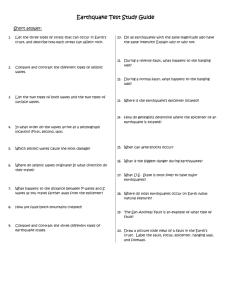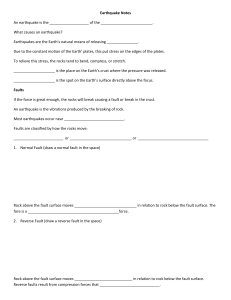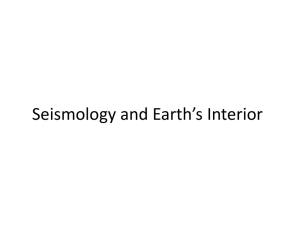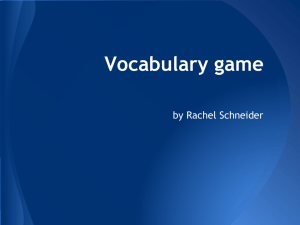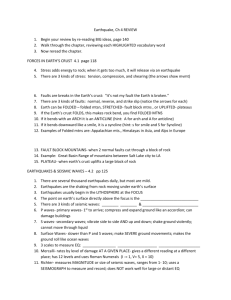File
advertisement
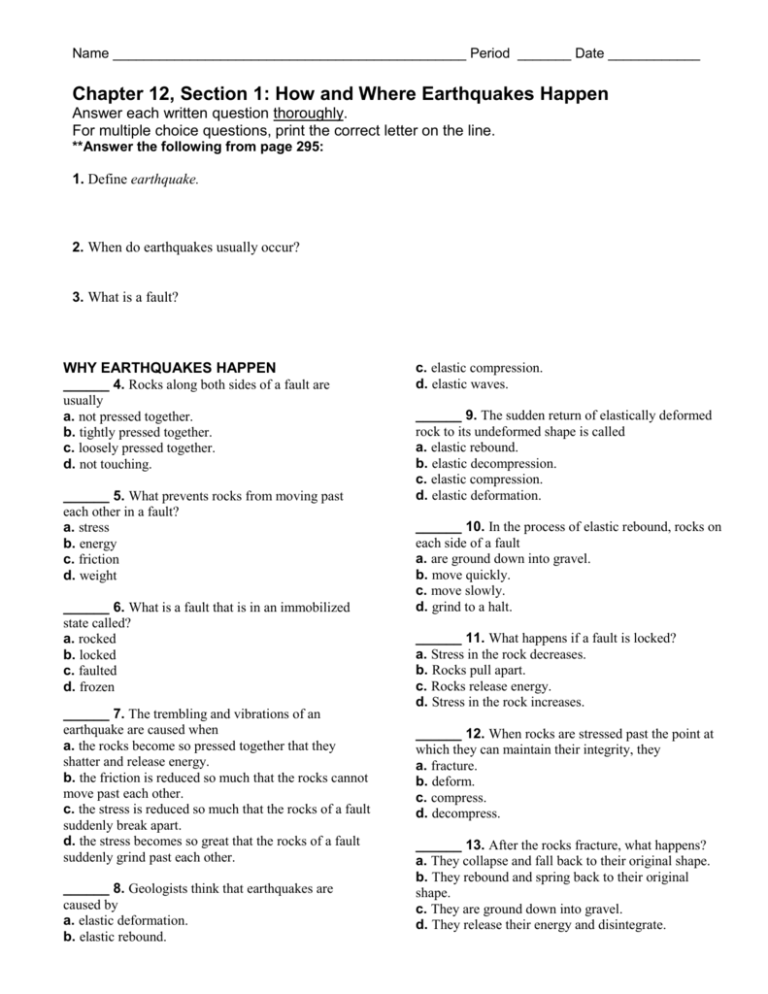
Name ______________________________________________ Period _______ Date ____________ Chapter 12, Section 1: How and Where Earthquakes Happen Answer each written question thoroughly. For multiple choice questions, print the correct letter on the line. **Answer the following from page 295: 1. Define earthquake. 2. When do earthquakes usually occur? 3. What is a fault? WHY EARTHQUAKES HAPPEN ______ 4. Rocks along both sides of a fault are usually a. not pressed together. b. tightly pressed together. c. loosely pressed together. d. not touching. ______ 5. What prevents rocks from moving past each other in a fault? a. stress b. energy c. friction d. weight ______ 6. What is a fault that is in an immobilized state called? a. rocked b. locked c. faulted d. frozen ______ 7. The trembling and vibrations of an earthquake are caused when a. the rocks become so pressed together that they shatter and release energy. b. the friction is reduced so much that the rocks cannot move past each other. c. the stress is reduced so much that the rocks of a fault suddenly break apart. d. the stress becomes so great that the rocks of a fault suddenly grind past each other. ______ 8. Geologists think that earthquakes are caused by a. elastic deformation. b. elastic rebound. c. elastic compression. d. elastic waves. ______ 9. The sudden return of elastically deformed rock to its undeformed shape is called a. elastic rebound. b. elastic decompression. c. elastic compression. d. elastic deformation. ______ 10. In the process of elastic rebound, rocks on each side of a fault a. are ground down into gravel. b. move quickly. c. move slowly. d. grind to a halt. ______ 11. What happens if a fault is locked? a. Stress in the rock decreases. b. Rocks pull apart. c. Rocks release energy. d. Stress in the rock increases. ______ 12. When rocks are stressed past the point at which they can maintain their integrity, they a. fracture. b. deform. c. compress. d. decompress. ______ 13. After the rocks fracture, what happens? a. They collapse and fall back to their original shape. b. They rebound and spring back to their original shape. c. They are ground down into gravel. d. They release their energy and disintegrate. **Answer the following from page 296: ______ 14. The location within Earth along a fault where the first motion of an earthquake occurs is called the a. epicenter. c. focus. b. fault. d. shadow. 15. Define epicenter. 16. About 90% of continental earthquakes have a shallow _____________ . 17. Earthquakes that take place within 70 km of Earth’s surface have ________________ foci. 18. Earthquakes with intermediate foci occur at what depths? ____________________________________ 19. Earthquakes with deep foci occur at what depths?___________________________________________ 20. Where do earthquakes that have deep foci usually occur? _____________________________________ 21. Why do earthquakes that usually cause the most damage have shallow foci? SEISMIC WAVES ______ 22. When rocks along a fault slip into new positions, they release energy in the form of vibrations called a. tidal waves. b. elastic waves. c. seismic waves. d. focus waves. ______ 23. Where do seismic waves travel? a. outward in all directions from the focus through the surrounding rock b. inward in all directions from the epicenter through the surrounding rock c. outward in all directions from Earth’s core through its surface d. inward in all directions from the focus through the epicenter ______ 24. How many types of waves do earthquakes produce? a. three b. six c. two d. 10 **Answer the following from page 297: In the space provided, write the letter of the definition that best matches the term or phrase. ______ 25. body wave ______ 26. surface wave ______ 27. p wave ______ 28. s wave a. a seismic wave that travels along the surface of a medium b. the fastest seismic wave; causes particles of rock to move in a back-and forth direction parallel to the direction in which the wave is traveling; can travel through solids, liquids, and gases c. the second-fastest seismic wave; causes particles of rock to move in a side-toside direction perpendicular to the direction in which the wave is traveling; can only travel through solids d. a seismic wave that travels through the body of a medium 29. What are two other names for P waves? ______________________________________________________ 30. What are two other names for S waves? ______________________________________________________ 31. How do surface waves form? 32. What are the two types of surface waves called? _______________________________________________ 33. Rock moves in what way as a result of a Love wave? 34. The ground moves in what way as a result of a Rayleigh wave? **Answer the following from page 298: SEISMIC WAVES AND EARTH’S INTERIOR ______ 35. The composition of the material through which P waves and S waves travel affects a. the power and duration of the waves. b. the angle that the waves travel. c. the speed and direction of the waves. d. the intensity and composition of the waves. ______ 36. What type of materials do P waves travel through fastest? a. materials that are not rigid and not easily compressed b. materials that are very rigid and not easily compressed c. materials that are not rigid and are easily compressed d. materials that are very rigid and are easily compressed ______ 37. What did Croation scientist Andrija Monorovicic discover in 1909? a. The speed of seismic waves increases abruptly at about 30 km beneath the surface of continents. b. The speed of seismic waves decreases abruptly at about 30 km beneath the surface of continents. c. The speed of seismic waves increases abruptly at about 30 km above the surface of continents. d. The speed of seismic waves decreases abruptly at about 30 km beneath the surface of oceans. 38. Name the three main compositional layers of Earth. _____________________________________________ 39. Name the five mechanical layers of Earth. ____________________________________________________ __________________________________________________________________________________________ 40. Define shadow zone. 41. Why do shadow zones exist? 42. What happens to seismic waves as they travel through materials of differing rigidities? 43. Why don’t S waves reach the S-wave shadow zone? 44. How does a P-wave shadow zone form? **Answer the following from page 299: EARTHQUAKES AND PLATE TECTONICS In the space provided, write the letter of the description that best matches the term or phrase. ______ 45. tectonic plate boundaries ______ 46. convergent plate boundaries ______ 47. divergent plate boundaries ______ 48. continental plate boundaries a. a point at which two continental plates converge, diverge, or move horizontally in opposite directions b. a point at which plates move away from each other c. a point at which stress on rock is the greatest d. a point at which plates move toward each other and collide 49. Why do earthquakes occur along the mid-ocean ridges? **Answer the following from page 300: FAULT ZONES ______ 50. A fault zone is a region of a. numerous, closely spaced faults. b. a few, closely spaced faults. c. Earth’s core where the rocks form faults. d. Earth’s mantle where faults form. 51. Why do fault zones occur at plate boundaries? 52. What is the name of the fault zone that extends almost the entire length of Turkey? 53. How did the New Madrid, Missouri, earthquake differ from many other major earthquakes in terms of its location? 54. What was discovered in the Mississippi River region in the late 1970s? 55. When did a major fault zone in the North American plate form?


